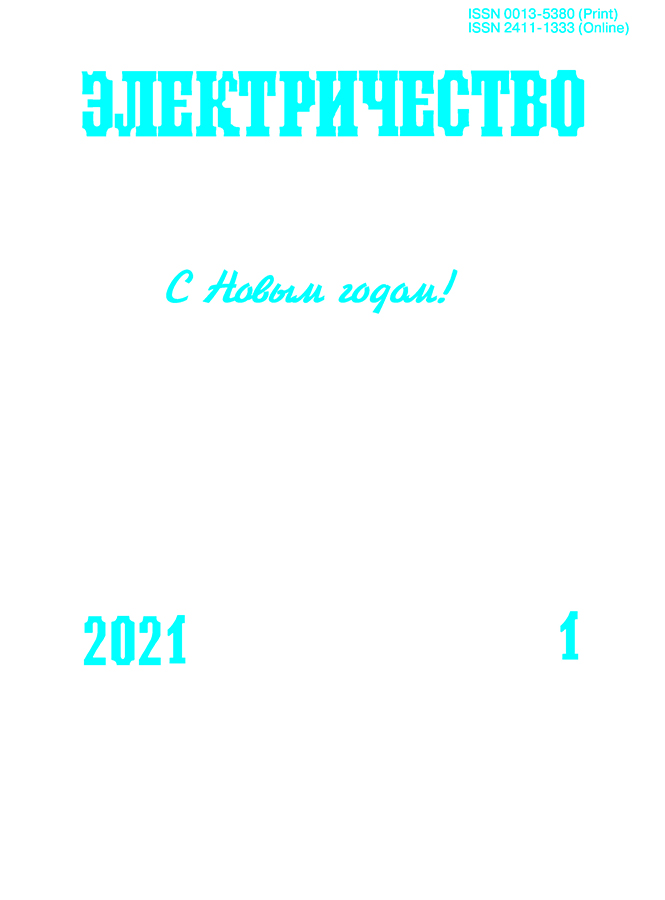Determination of Damping Factors Based on the Measured Frequency Responses of Power Transformer Windings. Part 1. Theoretical Consideration
DOI:
https://doi.org/10.24160/0013-5380-2021-1-13-22Keywords:
power transformers, resonance overvoltages, winding, frequency response, free oscillations, damping factorAbstract
To model high-frequency processes and determine the stresses on the internal insulation of transformer windings, reliable high-frequency models of power transformers are required. The accuracy of modeling high-frequency resonance processes in the windings depends on how correctly the model reproduces the natural frequencies and damping of free oscillations in the windings. To construct and verify high-frequency models of power transformers, it is necessary to have experimentally obtained data on the values of damping factors. There is a known method for determining the winding damping factors based on measurements of the voltage transfer functions at the internal points of the windings and their subsequent processing using the vector fitting technique, but its application is not always possible in practice. The article presents the results of theoretical studies performed for a simplified transformer winding equivalent circuit. It is shown that the damping factors can be estimated from the width of the resonance peaks of the frequency responses of the voltage modulus and reactive component at the midpoint of the equivalent circuit, and from the input admittance resistive component and current in the neutral of the considered resonance circuit.
References
1. CIGREBrochure 577A. «Electrical Transient Interaction between Transformers andthe Power System. Part 1: Expertise». Joint Working Group A2/C4.39, April2014. ISBN: 978-2-85873272-2.
2. CIGREBrochure 577B. «Electrical Transient Interaction between Transformers andthe Power System. Part 2: Case Studies». Joint Working Group A2/C4.39,April 2014. ISBN: 978-2-85873272-2.
3. Ларин В.С., Матвеев Д.А. Аппроксимацияпереходных резонансных напряжений и токов в обмотках силовых трансформаторовдля определения собственных частот колебаний и коэффициентов затухания. — Электричество, 2020, №12, с. 44-54.
4. GustavsenB., Portillo A. A Damping Factor-Based White-Box Transformer Model forNetwork Studies. — IEEE Transactions on Power Delivery, 2018, vol. 33, No. 6, pp. 2956 — 2964. DOI:10.1109/TPWRD.2018.2847725.
5. GustavsenB., Martin C., Portillo A. Time-Domain Implementation of Damping FactorWhite-Box Transformer Model for Inclusion in EMT Simulation Program. — IEEE Transactions on Power Delivery, 2020, vol. 35, No. 2, pp. 464—472.DOI: 10.1109/TPWRD.2019.2902447.
6. FergestadP.I., Henriksen T. Transient Oscillations in Multiwinding Transformers. — IEEE Trans. on Power Apparatus and Systems, 1974, vol. 93, No. 2, pp.500—509.
7. Белецкий З.М., Бунин А.Г., Горбунцов А.Ф., Конторович Л.Н. Расчет импульсных воздействий в обмотках трансформаторов с применением ЭВМ. М.: Информэлектро, 1978, 79 с.
8. Zheng Y.M., Wang Z.J. Determining the broadband loss characteristics of power transformer based on measured transformer network functions and vector fitting method. — IEEE Trans. Power Delivery, 2013, vol. 28, No. 4, pp. 2456—2464.
9. Gustavsen B., Semlyen A. Rational Approximation of Frequency Domain Responses by Vector Fitting. — IEEE Trans. on Power Delivery, 1999, vol. 14, No. 3, pp. 1052—1061.
10. IEC 60076-18:2012. Power transformers. Part 18: Measurement of frequency response. ISBN 978-2-83220-222-7.
11. Ларин В.С., Волков А.Ю. Резонансные перенапряжения в обмотках трансформаторов. Ч.2. Определение резонансных частот обмоток. — Электричество, 2015, № 12, c. 20—25.
12. Бессонов Л.А. Теоретические основы электротехники. Электрические цепи. М.: Высшая школа, 1996, 638 с.
13. Демирчян К.С., Нейман Л.Р., Коровкин Н.В., Чечурин В.Л. Теоретические основы электротехники: Учебник для вуСПб.: Питер, 2003, 463 с.
#
1. CIGRE Brochure 577A. «Electrical Transient Interaction between Transformers and the Power System. Part 1: Expertise». Joint Working Group A2/C4.39, April 2014. ISBN: 978-2-85873272-2.
2. CIGRE Brochure 577B. «Electrical Transient Interaction between Transformers and the Power System. Part 2: Case Studies». Joint Working Group A2/C4.39, April 2014. ISBN: 978-2-85873272-2.
3. Larin V.S., Matveyev D.A. Elektrichestvo — in Russ. (Electricity), 2020, No. 12, pp. 44—54.
4. Gustavsen B., Portillo A. A Damping Factor-Based White-Box Transformer Model for Network Studies. — IEEE Transactions on Power Delivery, 2018, vol. 33, No. 6, pp. 2956 — 2964. DOI: 10.1109/TPWRD.2018.2847725.
5. Gustavsen B., Martin C., Portillo A. Time-Domain Implementation of Damping Factor White-Box Transformer Model for Inclusion in EMT Simulation Program. — IEEE Transactions on Power Delivery, 2020, vol. 35, No. 2, pp. 464—472. DOI: 10.1109/TPWRD.2019.2902447.
6. Fergestad P.I., Henriksen T. Transient Oscillations in Multiwinding Transformers. — IEEE Trans. on Power Apparatus and Systems, 1974, vol. 93, No. 2, pp. 500—509.
7. Beletskiy Z.M., Bunin A.G., Gorbuntsov A.F., Kontorovich L.N. Raschet impul’snykh vozdeystviy v obmotkakh trans/ormatorov s primeneniyem EVM (Calculation of impulse influences in transformer windings using a computer). M.: Informelektro, 1978, 79 p.
8. Zheng Y.M., Wang Z.J. Determining the broadband loss characteristics of power transformer based on measured transformer network functions and vector fitting method. — IEEE Trans. Power Delivery, 2013, vol. 28, No. 4, pp. 2456—2464.
9. Gustavsen B., Semlyen A. Rational Approximation of Frequency Domain Responses by Vector Fitting. — IEEE Trans. on Power Delivery, 1999, vol. 14, No. 3, pp. 1052—1061.
10. IEC 60076-18:2012. Power transformers. Part 18: Measurement of frequency response. ISBN 978-2-83220-222-7.
11. Larin V.S., Volkov A.Yu. Elektrichestvo — in Russ. (Electricity), 2015, No. 12, pp. 20—25.
12. Bessonov L.A. Teoreticheskiye osnovy elektrotekhniki. Elektricheskiye tsepi (Theoretical foundations of electrical engineering. Electrical circuits). M.: Vysshaya shkola, 1996, 638 p.
13. Demirchyan K.S., Neyman L.R., Korovkin N.V., Chechurin V.L. Teoreticheskiye osnovy elektrotekhniki: Uchebnik dlya vuzov, tom 1 (Theoretical foundations of electrical engineering: Textbook for universities, vol. 1). SPb.: Piter, 2003, 463 p.




